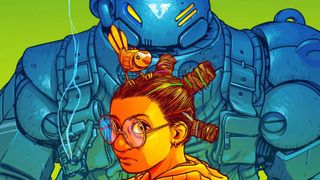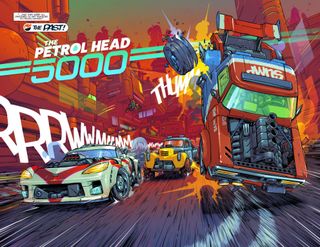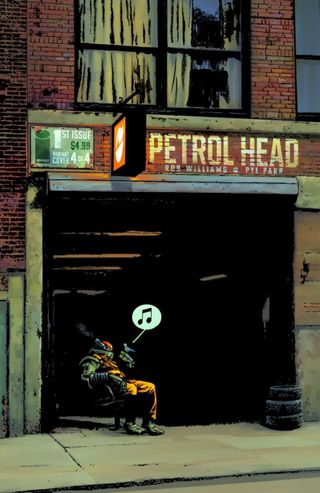Start your engines! Image's Petrol Head is a high-octane sci-fi racer
Interview | Rob Williams and Pye Parr tell us about their brilliant robot racing comic

Hot Rod racing and big robots meet in Petrol Head, a new sci-fi series from veteran Judge Dredd writer Rob Williams and artist Pye Parr.
The series, published by Image, follows a down-on-his-luck robot known as Petrol Head who gets entangled with a young girl and her father who are on the run from the authorities.
What follows is a high-speed chase through the O-Zone, a domed city of the future that houses the remnants of humanity following a climate catastrophe. The two humans may have a way to save their people, but the robots aren't going to make that easy for them...
Petrol Head's double-length #1 - the first of five issues in the series' initial run - is a blockbuster start to an exciting new comic. Action-packed, funny, but with a hint of melancholy, it's both immediately accessible and hints at a rich wider world just waiting to be explored.
Newsarama sat down with its creators to find out more...

Newsarama: To start, how would you sum up the story of Petrol Head?
Rob Williams: It's set in a future where there's been a climate emergency and all of humanity lives in domed cities. The robot administrators of the city have to keep the humans entertained to stop them going insane, so there's all these extreme sports, one of which is giant robots smashing into each other in Hot Rod races, but these "Petrol Heads" went out of fashion and are now obsolete.
Comic deals, prizes and latest news
Get the best comic news, insights, opinions, analysis and more!
Our main character lives on his own in a garage in a place called the Smogzone where no humans live. Then one day a very smart 12 year old girl called Lupa and her father, who are on the run from the authorities, hide in his garage. They may have an invention which could potentially make the environment breathable again, but the robots who run the city don't want that to get out. The police turn up and that sets them off on a race through the city to try and escape.

The city is run by a robot called The O. What can you tell me about him?
Rob: I really like The O. Because he's in charge of running the entire city, Pye drew him to have this enormous head with all these eyes on it. He's got this huge brain, but something's gone a bit wrong in his wiring somewhere. Lupa and her father are going to have to open part of the dome to try and get to the outside environment and he thinks that if they do that, it could kill everyone. He thinks he's protecting people, so he's not evil, but something has become detached in him somewhere along the way.
What led to the two of you working together on the series?
Pye Parr: I draw a lot of cars and I wanted to find a way of linking all these images together. A few years back during lockdown I was getting sick of the freelance work that I was picking up. It didn't have any direction and it was purely for money. So I thought, I'll take two weeks out and just draw whatever I fancy drawing, which ended up being these futuristic cars with big engines, and then I added some robot drivers.
I had a vague idea of doing some kind of art book, but Rob saw them and said, "Oh these would make a good comic." We went from there, really.
Rob: From my point of view I just remember seeing those pictures and thinking that they looked like a comic. Cars are not necessarily my thing - I know they're very much Pye's - but the art was so good. Then it was just coming up with the characters and, like with any story, you look for the narrative and what's going to keep the readers engaged.
One of the things with Image is that you have to have a big chunk of work finished before you can announce it to the world. But prior to that there was an awful lot of development work between me and Pye. We really went to town on the pitch document, so it was largely fully formed by the time it even got to Image.

So this pitch document was basically your series bible?
Pye: Yeah, that's right. And some of the ideas in it we don't really come back to. There's stuff in the pitch that we've never referred to in the story, but it's in the back of our heads when we're working on stuff.
Rob: You organically build the world out and that happens with any story. You go in with a plan, and then you're writing it and it grows. But it all started with the character, basically, and that was based on Pye doing these amazing pictures of robots and futuristic racing cars, and building a world that could contain that kind of technology. Then it was doing the 2000 AD thing of naming the strip after the main character! Though I forget who came up with the name Petrol Head.
Pye: You did. As soon as you said it, the whole thing just sort of dropped fully-formed onto the page. It was like, "It's called Petrol Head and he's literally got an engine for a head, and he drives a car." That's brilliant. I know exactly where I'm going with that.
Rob: The main selling point of the book is how good it looks. Pye's colors are amazing and we talked a lot about things like Akira, where the sense of speed on the page really comes across. That's really rare in a comic, but I think Petrol Head has that.

This is something I was going to ask, and it's a very basic question, but how do you do that? How do you make things look like they're moving so fast?
Pye: One of the things I tried to do was to kind of lose the edges of things. I did a lot of oil paintings of cars a few years ago, and it was easy to get a sense of motion, because you can be very loose.
The way I draw things for a comic is much tighter and I'm not a fan of doing Photoshop effects, where there's lots of blurs, so I found a way to sort of stretch the art out. One of the benefits of working digitally is I can draw in a way that you can't do if I was doing line work and scanning it in, you know? And then yeah, a low angle, and a nice bit of perspective.
I like the weight of the cars, I think that's quite an important thing to get. It's not just making them look cool, it's making them lean and roll into the corners. There's a few panels that I'm pleased with, where it really feels like they're moving around.

You also colored the book, Pye. What were your considerations while working on that?
Pye: I did the first page of the first issue a long time before anything else, and I deliberately gave it this really strong orange light and that sort of stuck, and fed into the storytelling. The different areas of the city are very obviously color-coded. At the start of the story they're all in this big dome and there's a lot of orange light, and it's very artificial looking. Then it switches to an interior scene in the lab and everything's very blue and pale and white. And then it changes again when they go to the Smogzone. I like that, it's a very visual indicator of where you are in the story.
What are your hopes for Petrol Head?
Rob: It just feels like it’s got a lot of potential and the characters felt weirdly fully formed when they first turned up. That's an easy thing to say, but it's true. By the end of the first arc, we've only shown you one bit of the city and there's all kinds of other places that we could go.
Petrol Head #1 is published by Image on November 8 and can be pre-ordered now.
Hungry for more giant robots? Check out our interview with Daniel Warren Johnson about his new Transformers comic.

Will Salmon is the Comics Editor for GamesRadar/Newsarama. He has been writing about comics, film, TV, and music for more than 15 years, which is quite a long time if you stop and think about it. At Future he has previously launched scary movie magazine Horrorville, relaunched Comic Heroes, and has written for every issue of SFX magazine for over a decade. He sometimes feels very old, like Guy Pearce in Prometheus. His music writing has appeared in The Quietus, MOJO, Electronic Sound, Clash, and loads of other places and he runs the micro-label Modern Aviation, which puts out experimental music on cassette tape.
Most Popular



